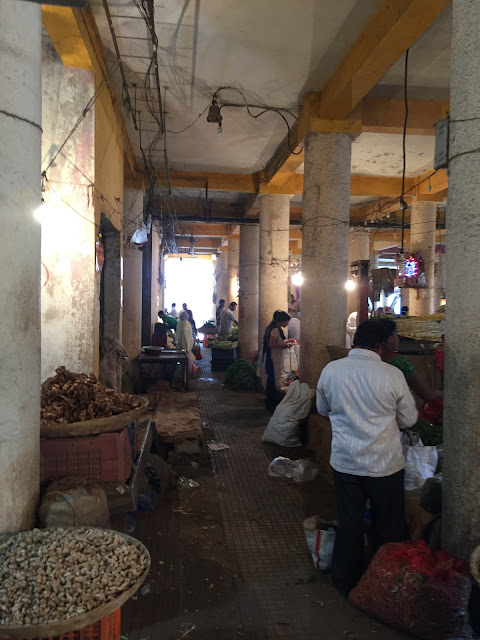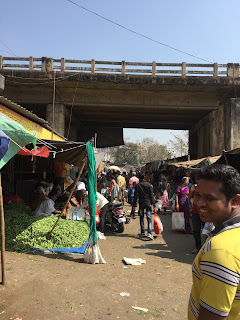When my Mom was visiting, she took everything in with wide open eyes. I was in awe of her ability, at age 76, to come here and view everything in awe. She saw the beauty and the color where I have often struggled to see past the dirt and the poverty. Balu also saw her openminded awe and loved taking her out to show her around. On her second to last day here, he took us to the market where he shops for his food for his family.
 |
| Can you pick her out of the crowd? |
I've often been told I needed to experience Mandai Market and Shivaji market, but we live on the other side of town and it is an excursion to get over there. It doesn't seem like it should be, because it's about 14 kilometers away. But in Pune, that's at least 45 minutes and often an hour and a half. So it's fine for a visit, but not for regular shopping. But Pimpri Market is about 15 minutes from our house and it is the real deal. I don't speak any Marathi, so Balu comes with me, but my novice Hindi helps a bit and they're always amazed I speak any-though I'm finding most vendors speak only Marathi.
I instantly fell in love with Pimpri Market, and Mom declared it the best thing she'd seen in India. It is huge. It's under and around a huge overpass. There are hundreds of stalls selling fresh vegetables and fruit, dried fish, chilis, spices and herbs. Everything is so beautiful and fresh, or freshly dried and fragrant. Have you ever smelled a guava? When they are ripe, they overpower everything with their sweet, floral scent. Mix this with cilantro (coriander), masala, incense and smoke, body odor and fish, smoke and diesel, flowers, and hot oil and fried food from the street food vendors and you have the scents of India. Waft a bit of sewage and rotting garbage through it all and it's a complete experience (luckily those last scents waft through but don't often stay for long).
 |
| Grace and I adore figs and they are so sweet and fresh and flavorful here. The green fruit next to the figs are guava. |
 |
| These are 1 to 3 feet long and called drumsticks. They are also used in sambar. |
 |
| More varities of dried fish than I could identiy |
I, sadly, did not bring my good camera that day. And my iPhone just could not capture the size of the market. In the picture below, if you look closely, you can see that the stalls run down about as far as you can see. It's like that in every direction. It seems impossible that there could be a market for this much produce. After all, it's in the 80s to 90s every day and things spoil really, really quickly. But then you take your mind outside into the traffic (or even stop staring at the produce and realize how crowded it is right where you're standing) and the hustle and bustle of teeming humanity, and remember that there are millions of people to feed right here in Pune. Many millions.
Look at this bounty! And the pride each vendor takes in his or her display. Everything is artfully arranged and maintained and rearraged as people sort through the piles. Many people call out to you as you pass, advertising what they have and that it's the best today, the freshest, the best price. I can't understand a lot of what they are calling, and yet I can. It's like you absorb the understanding through your skin, and inhale it like smoke. The vendors and shoppers are also diverse with Muslim stands right next to Hindi stands, all sharing the same chai from the same wallah, peacefully and happily coexisting and even supporting each other. I'm sure there are many other religions mixed in, but you can assume Hindi and identify Muslims and Sikhs from their headwear. Pimpr market, like so much of India, exemplifies religious choice as bountiful and acceptable as the produce.
 |
| Next Monday I'll try to get better pictures of the scales. They are wonderful old scales that they counter with old iron weights. |
The stalls have aisles on each side where smaller displays are set up, and then there are alleys and by-ways selling spices and decorations, jewelry and colored powders. The backside aisles seem to contain more ginger, turmeric (the root), garlic, onions and potatoes-things that don't make you draw your breath in awe at the colors, but which make your food taste like the bounty looks-rich, diverse, full of flavor. I'm quite sure you could get everything you need to live right in and around this market.
As always in India, I'm nearly struck dumb by the electricity and the wiring. It's amazing and confounding to see. I've watched men work with the wires and seen them just cut the plug part off the wire, strip the wires, then plug the raw, exposed wires directly into the outlet. The wires connect this way and that, like a non-geometric spider's web. If someone wants power and doesn't have it, they may well just strip a bit of someone else's wire away and attach their wire directly to it. Problem solved. But who's electricity bill covers it?
 |
| Drinking his chai. |
I always ask before I photograph people (unless I'm cruising past in the car). I think it is the respectful thing to do. And I honor it when they say no, or when I cannot be sure they said yes. But it's hard to get the candid shot. This young man had just receieved his tea from the chai wallah and was settling in to drink it. His pose is exactly the same as it had been before he saw me, but the direct and cheeky expression in his eyes has certainly changed. As it's a look I often see as I'm stared at wherever I go, I am glad I missed the candid shot and captured a bit of my reality instead. Look into his eyes. He's looking directly at me, staring. There is a bit of wonder and a lot of amusement in his look, and a bit of a challenge too.
 |
| This little boy was working with his family, selling the "popcorn." |
When you decide you want to buy something, they'll often hand you a big, battered aluminum bowl. You choose what you want and hand it back to be weighed. Some vendors want to choose for you, but I often find these are the ones who will sneak in a rotting berry or battered cucumber. Others insist you taste their apples, mangoes, strawberries and oranges before you buy. Either way it's far better than buying the plastic wrapped produce at the expat stores where you can't get close to any of it. Plus, it's about 20% of the price here at the open market than outside at the stores.
The side aisles in the market are largely dried things, especially spices and fish. I think the fist stalls are fascinating. They have the tiny dried fish in addition to large steaks cured and dried in salt that you just pan cook, It's an ancient way to preserve meat without refrigeration, but it's quite new to me.
 |
| Look at the variety. The pink is shrimp. He even has eggs. I do wonder what you use the dogfish (shark) for. |
The market is surrounded by narrow, densely populated alleyways that are packed with small shops selling clothes, shoes, ornaments, fabric, electronics, sewing machines(often man powered) and more. It's overwhelming to the senses with the hustle and bustle and hawkers and children and ever present dogs combined with the languid walk of the men and the quiet repose of the women waiting on customers. Again, the contrasts of India: where everything is teeming and fast and loud, and everything is languid and unhurried, seemingly all at the same time.
 |
| Very few electric sewing machines, which makes sense because even if you do have electric power where you live, you lose it often. |

















No comments:
Post a Comment